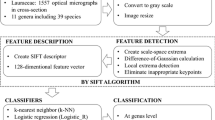Abstract
In the wood industry, there is a wish to recognize and track wood products through production chains. Traceability would facilitate improved process control and extraction of quality measures of various production steps. In this paper, a novel wood surface recognition system that uses scale and rotationally invariant feature descriptors called K-plets is described and evaluated. The idea behind these descriptors is to use information of how knots are positioned in relation to each other. The performance and robustness of the proposed system were tested on 212 wood panel images with varying levels of normally distributed errors applied to the knot positions. The results showed that the proposed method is able to successfully identify 99–100 % of all panel images with knot positional error levels that can be expected in practical applications.






Similar content being viewed by others
References
Åstrand E (1996) Automatic inspection of sawn wood. Linköping studies in science and technology. Linköping University, Linköping
Besl PJ, McKay ND (1992) A method for registration of 3-d shapes. IEEE T Pattern Anal 14:239–256
Broman NO, Nyström J, Oja J (2008) Modelling the connection between industrially measured raw material properties and end user preferences. Part 2: results from preference studies. In: Proceedings of the IUFRO Working Party 5.01.04, Joensuu, Finland
Brown M, Lowe DG (2007) Automatic panoramic image stitching using invariant features. Int J Comput Vision 74:59–73
Chang SH, Cheng FH, Hsu WH, Wu GZ (1997) Fast algorithm for point pattern matching: Invariant to translations, rotations and scale changes. Pattern Recognit 30:311–320
Chen Y, Medioni G (1992) Object modelling by registration of multiple range images. Image Vis Comput 10:145–155
Chikkerur S, Cartwright A, Govindaraju V (2005) K-plet and coupled bfs: a graph based fingerprint representation and matching algorithm. In: Zhang D, Jain A (eds) Advances in biometrics, vol 3832 of Lecture Notes in computer science. Springer, Berlin, pp 309–315
Dykstra DP, Kuru G, Taylor R, Nussbaum R, Magrath WB, Story J (2002) Technologies 325 for wood tracking, In: Environmental and social development East Asia and Pacific Region 326 Discussion Paper. Technical Report. World Bank
Fischler MA, Bolles RC (1981) Random sample consensus: a paradigm for model fitting with applications to image analysis and automated cartography. Commun ACM 24:381–395
Flodin J (2009) KAP—Kontinuerlig Automatisk Provsågning. Technical Report. WoodCenter North. In Swedish
Funck J, Zhong Y, Butler D, Brunner C, Forrer J (2003) Image segmentation algorithms applied to wood defect detection. Comput Electron Agric 41:157–179
GoldenEye, Microtec GmbH. http://www.microtec.eu
Gonzalez R, Woods R (2008) Digital image processing, 3rd edn. Pearson Prentice Hall, Englewood Cliffs
Gruen A, Akca D (2005) Least squares 3d surface and curve matching. ISPRS J Photogramm 59:151–174
Jain AK, Flynn P, Ross AA (2007) Handbook of biometrics. Springer New York Inc, Secaucus
MathWorks MATLAB (2013a) Image processing toolbox: 2013b. The MathWorks Inc., Natick
MathWorks MATLAB (2013b) Computer vision system toolbox: 2013b. The MathWorks Inc., Natick
Nyström J, Oja J, Broman NO (2008) Modelling the connection between industrially measured raw material properties and end user preferences. Part 1: the simulation tool. In: Proceedings of the IUFRO working party 5.01.04, Joensuu
Oja J, Broman NO, Nyström J (2008) Modelling the connection between industrially measured raw material properties and end user preferences. Part 3: optimizing the industrial production. In: Proceedings of the IUFRO working party 5.01.04, Joensuu
Otsu N (1979) A threshold selection method from gray-level histograms. IEEE Trans Syst Man Cybern 9:62–66
Spratling BB, Mortari D (2009) A survey on star identification algorithms. Algorithms 2:93–107
Todoroki C, Lowell E, Dykstra D (2010) Automated knot detection with visual post-processing of douglas-fir veneer images. Comput Electron Agric 70:163–171
Uusijärvi R (2000) Automatic tracking of wood. Ph.D. thesis. Kungliga Tekniska Högskolan. Institutionen för produktionssystem
WoodEye, Innovativ Vision AB. http://www.woodeye.se
Acknowledgments
This work has been part of the Hol-i-Wood Patching Robot project and received funding from the European Union’s Seventh Framework Programme (FP7/2007-2013) under Grant Agreement No. 284573. The Hol-i-Wood PR is a collaboration between Luleå University of Technology (LTU), TU Wien and TU München, as well as industrial partners: MiCROTEC, Springer, TTTech and LIP-BLED.
Author information
Authors and Affiliations
Corresponding author
Rights and permissions
About this article
Cite this article
Pahlberg, T., Johansson, E., Hagman, O. et al. Wood fingerprint recognition using knot neighborhood K-plet descriptors. Wood Sci Technol 49, 7–20 (2015). https://doi.org/10.1007/s00226-014-0679-3
Received:
Published:
Issue Date:
DOI: https://doi.org/10.1007/s00226-014-0679-3




